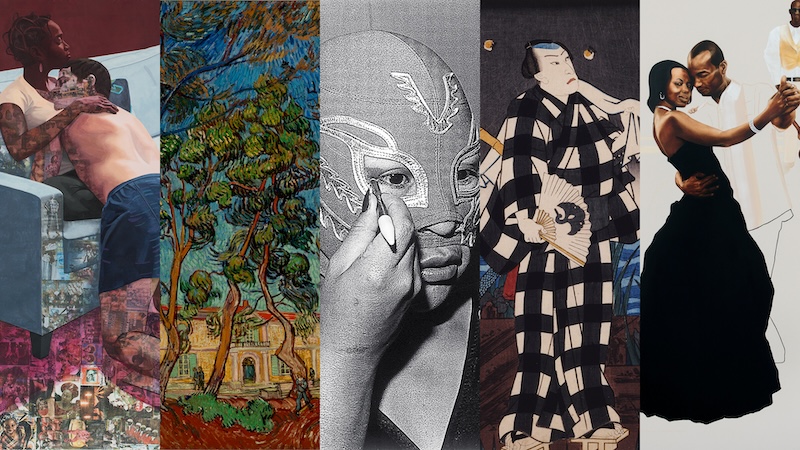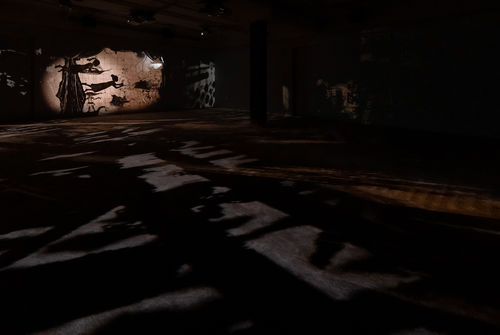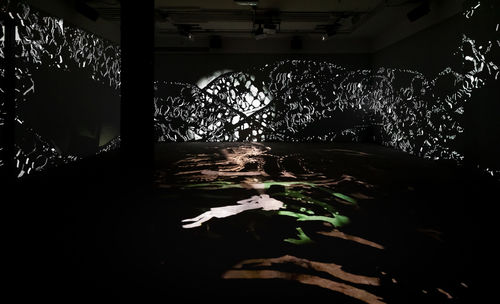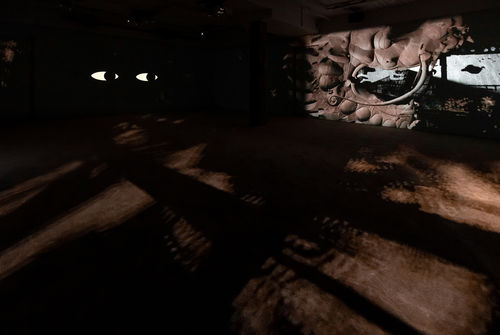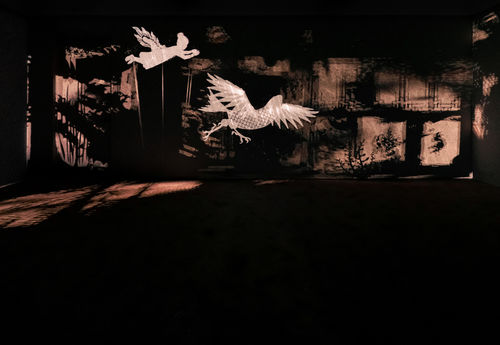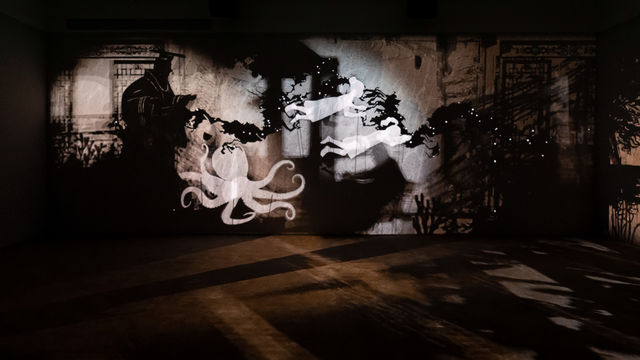
Hammer Projects: Lap-See Lam
- – This is a past exhibition
Lap-See Lam is a Stockholm-based artist whose animation, films, virtual reality, and sculptural works consider how mythology, popular culture, and fiction can both define and alter perceptions of the self and cultural belonging. This exhibition features Lam’s immersive video installation Tales of the Altersea (2023), a work inspired by the ruins of a dragon-shaped ship that Lam could see from her studio window in art school. In 1990 the ship sailed from Shanghai to Gothenburg, Sweden, with the intention of serving Chinese food to European customers across ports in the North and Baltic Seas. The gastronomic venture didn't go as its owner had hoped, and the seafaring restaurant would eventually be abandoned. The ruins of this historic vessel serve as a jumping-off point for Lam’s dreamlike story of loss, memory, and resilience.
Hammer Projects: Lap-See Lam is organized by Pablo José Ramírez, curator, with Jessi DiTillio, curatorial assistant.
Essay
Lap-See Lam interviewed by Pablo José Ramírez
Pablo José Ramírez: Your research and your practice are deeply rooted in material culture. You were born in and are based in Stockholm, but your family immigrated from Hong Kong. I would like to begin by asking if you would like to share something about your connection to material culture and to the Chinese diaspora.
Lap-See Lam: I think it started in a feeling of loss, a need to grasp this particular space that is very much connected to and very present within my history and my family history, as well as that of the Cantonese diaspora in general, not only in Sweden but also in the Nordic countries and in Europe and the US and so on, although the histories of the Hong Kong Chinese diaspora differ from region to region.
I started this project as a very personal one. My family was about to sell the restaurant that my grandmother had opened in the 1970s. She had moved from Hong Kong to the UK to work in the restaurant business, and then she moved to Sweden to learn the business of Chinese restaurants there. So my siblings and I grew up in a Chinese restaurant, and we lived in an apartment just above the restaurant. It has been present in all of our lives, but we have never spoken about this place or understood it on an intellectual level. It has just been there, this other home for us.
But I think all of us, especially since we were all born in Sweden and grew up here, understood this place as a performative space, as a space where identity and our community were performed for a certain gaze. And I think we felt this before we had words for it. So when my parents decided to sell it, I immediately felt a need to grasp it somehow, to document it. And then, during the same time I was getting ready to do this, I also realized that many other restaurants in Sweden were struggling as businesses and were starting to close, one by one. So I thought it was interesting that this was happening during that period of time, in the early 2010s, and that it was deeply connected to the generation before mine, our parents, and the generation before that, and that this history of the diaspora has not been documented at all in this area, in the Nordic countries.
So I started to 3D-scan the restaurants and slowly built up an archive. I didn’t really think of it as a project in those terms, as an art project, even though I was an art student by that time. I had this idea of creating realistic renderings of these spaces. But as soon as I started to work on it, I realized that what came out of the 3D scans was a material filled with glitches and holes and an incompleteness, which evoked questions about memory and the idea that you somehow cannot preserve it.
So that moment of realization—that this material speaks of this idea of loss between cultures and languages and generations and that the material itself could speak about this without me trying to intellectualize—that moment opened up all of the work that came after. That was the beginning of it. It really was an unplanned project that didn’t start as an art project per se but became something I needed to do.
PJR: There is something about this project and your practice as artistic methodology that works as spectral performativity. And I say this because it connects to my next question. These projects are based on the potentialities of world-building. It feels at points that you are trying to build a second home after the loss of your parents’ restaurant. So you are still building a whole cosmos for yourself in that way, right?
LSL: Yes.
PJR: And there is a level of spectrality because it’s not that your body is actually present, but your body is somehow performing there. The traces of your bodily experience are there.
LSL: Right.
PJR: I know the story of the ship that had been the Sea Palace, a floating Chinese restaurant, which has become an important element in your work. How did that transition from things that are concrete—your family, the restaurant, the ship that you discovered when you were looking out the window of your studio in art school—to the world-building experience of your media projects happen?
LSL: The spaces needed certain voices, and I think the use of fiction as a method in the work came almost as a way to glue together the small pieces of the histories I had, like the histories of our family and how we ended up here somehow, how my grandmother ended up here, and the different decisions that led her to open a Chinese restaurant in Sweden. It’s something that we never spoke about, which I feel is connected to a quite typical first- and second-generation diasporic attitude. The nostalgia is not really present for many reasons.
And I think my work is a way to enter into questions like “Well, how come? How come our history is not more present in our lives but maybe also in the written history of our community here?” I think using storytelling and fiction was a way for me to come closer by also distancing myself from my personal history, sort of. So I could use the little bits and pieces that I’ve remembered or that I’ve maybe overheard that are connected to folktales or to certain parts of our family history and then rewrite them into something new, a parallel history, an ongoing story that I still feel I’m writing. I could dive into Cantonese mythology but also make it my own. Being able to be quite disrespectful in terms of the authenticity of the history has, I think, helped me in creating my own relationship to this idea of diaspora or history.
PJR: I think there’s something about being from the diaspora or from the global south that is embedded in our DNA and reflected in our artistic practices. Something that might be just a subject of research for someone else is part of your own story. And even when the work is, for instance, a work on speculation, it feeds from something that is real. The whole point of magic realism, for instance, is that it’s not just fiction; it’s actually based on our own experience of reality, but it can’t be completely rationalized. It is not fantasy, which I think is an important distinction. When I think of your work Tales of the Altersea (2023), I don’t see it as fantasy in that way. Does that make sense?
LSL: Yes, definitely. And I’ve been thinking of the Chinese restaurant as a magic realist place and as a place of doubleness. It has this double nature: it is a projected orientalist fantasy, but still there are all the stories and the lived experiences that have happened throughout these places. And that duality is the starting point of the narrations that I create.
I feel that with each exhibition and project that I do, I receive the opportunity to create these spaces, usually in a digital form, using the 3D scans as a basis, and that is what makes it possible for the stories to emerge. So often when I make these works, the stories and narrations come in the very last phase. The material comes first. I create the spaces. I maybe bring in a character again that I was starting to research for a previous project, and then I develop that further. So it really feels like I need to create the spaces first.
PJR: And now Tales is leading you to a different constellation of projects, right? What are some of those connections? Would you like to talk about your project for the Nordic Pavilion at the 2024 Venice Biennale?
LSL: Sure. I would say that The Altersea Opera is a continuation of Tales of the Altersea. I go deeper into the idea of this fish-man hybrid and the idea of Hong Kong but with the literal translation of its name, “fragrant harbor,” and the journey of the floating Sea Palace and how it ended up on the seabed, how it ended up sinking into the ocean, into the Altersea, which is the setting of Tales of the Altersea. So we have the ship already sunken into the Altersea, and then it’s discovered by twin girls. One day they’re learning to swim, but they swim down into the depths of the sea, but I would say that it’s also sort of into the depths of their minds.
So there’s the idea of connecting the sea with the psyche, the depths of the psyche as well, and the history of the girls, in which they meet different constellations. I mean, it’s a connection not only to this idea of the history of Hong Kong and its diaspora but also to the historical, the old methods of storytelling, such as the shadow play. In one scene we meet the emperor as a puppet figure, the crying figure in the work, the emperor Han Wudi of the Han dynasty, which is said to be one of the first versions of a shadow play. His favorite concubine died, and to help him through his sorrow, one of his employees re-created her by projecting her shadow with a light onto a tent. So that is one of the early depictions of the necessity of using the shadow play as an illusion to evoke certain emotions. He’s also part of the shadow play, and the girls are passing by him while swimming in the sea.
PJR: Something that I enjoy in your work is how you move between media, using digital design, sound, and performance, as in the opera in Venice. The fact that the media projects have performative and material components is also powerful. That is the point with the shadow play, right? There is something that is still very crafty about it. And I really appreciate that kind of craftiness in media works. So I think that probably speaks to your way of doing things, like the kinetic sculptures that also have a performative element. Some of them are activated by the movement of people.
LSL: Since I’m not really from the gaming world, I think I’m using the techniques of digital crafting in a very disrespectful way. I’m not schooled in areas like digital design or animation at all. So I work with it so freely, but I also work across mediums. That’s very natural for me, and I think of the work more as a whole, as an entity, in which I use sound, drawing, and storytelling in a very free form. Maybe it also comes from a lack of being good at one thing, but it’s very natural for me to work across mediums.
Hammer Projects are single-gallery exhibitions highlighting the work of contemporary artists from around the globe, often presenting new work at a pivotal moment of an artist’s development. Ongoing since 1999, Hammer Projects is a signature series within the Hammer’s exhibition program.
Hammer Projects is presented in memory of Tom Slaughter and with support from the Horace W. Goldsmith Foundation. Lead funding is provided by the Hammer Collective. Generous support is provided by Susan Bay Nimoy and Leonard Nimoy, with additional support from the Los Angeles County Board of Supervisors through the Department of Arts and Culture.
Hammer Projects: Lap-See Lam is made possible, in part, by the Pasadena Art Alliance.


